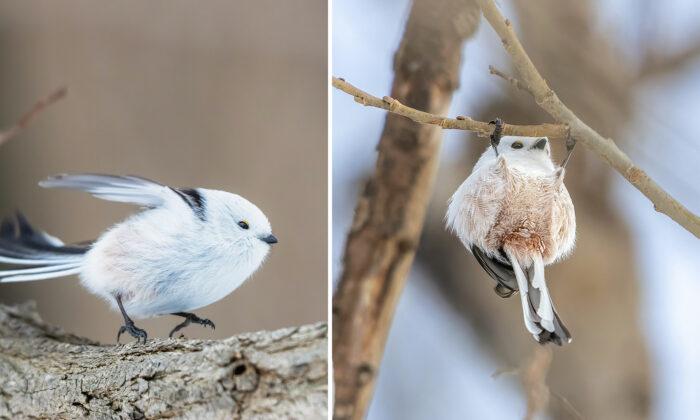These tiny, snowball-like Japanese birds attract visitors from far and wide to marvel at their cuteness. One skilled photographer has captured the little birds “working out” using delicate tree branches as their gym, and the images are almost too perfect to be real.
Shima-enaga, meaning “long-tailed island bird,” are known fondly as “snow fairies” in Japan. A subspecies of the long-tailed tit, they live in the forests of Hokkaido, Japan’s second-largest island.



Island native Hiroki Takahashi, who lives in the city of Sapporo, has been enraptured by snow fairies for some time. In December 2022, Hiroki captured a beautiful series of photos of the little bird “working out” after seeking snow fairies in the forest for a month.
“The long-tailed tit is very fast and very difficult to photograph, [but its] egg-like face is so cute that I walk over 20,000 steps a day to capture it,” Hiroki told The Epoch Times, describing his lucky day.
As the long-tailed tit doesn’t sit still in one place for long and keeps moving in various directions, Hiroki says he too has to assume different postures and positions to take a “cute frontal photo” of the little birds.




Using his Canon EOS R5 camera and 300mm lens, Hiroki captured many closeup shots of the snow fairies’ cute canopy acrobatics: bouncing along branches, hanging upside-down, diving through the air, and even appearing to do pull-ups on sturdy twigs.
Shima-enaga are small birds with a relatively long tail, typically weighing around one-fifth of an ounce (approx. 8 grams) and measuring 5 to 6 inches (approx. 13 to 15 centimeters) in adulthood. Omnivores, they feed mainly on insects and other invertebrates. Shima-enaga are seen year-round on the island but gain their puffy, round cuteness in the winter when they fluff their feathers for extra warmth.
Unlike the long-tailed tits of the mainland, adult shima-enaga lose their thick black “eyebrows,” such that their pristine white faces with tiny beaks resemble puffed-up cotton balls. Another unique feature of the fluffy little bird is that if they do not mate successfully in spring, individual birds will rally to help other members of their 20- to 30-strong flock raise their young.
A beloved emblem of the island of Hokkaido, shima-enaga often show up on souvenirs and handmade crafts.

Hiroki’s journey as a photographer moved through landscape and portrait photography before he became interested in single-lens reflex cameras after becoming a father. He started taking walks into nature and snapped his first photos of Ezo flying squirrels in early 2022. A love for taking photos of animals was born.
“It made me happy,” he told The Epoch Times. “Compared to the rest of the world, Hokkaido is very small, but in winter the animals become very cute with fluffy fur to prepare for the cold. I would be happy if we could spread that cuteness all over the world!”












